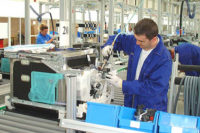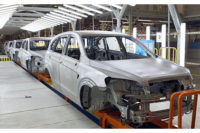This increase in median age can be found in all sectors of the economy, including manufacturing. According to the BLS, the 2011 median age for production occupations, including assemblers, was even higher than the national average, at 43.1 years.
The BLS recognizes more than 1 million assemblers in the U.S. workforce, with the majority of them being 45 to 64 years old. Nearly 15 percent of them assemble electronic, electrical and electromechanical products, and they have a median age of 45.9 years.
The remaining 85 percent assemble “engines and other machines,” “aircraft structures, surfaces, rigging and systems” and “miscellaneous items.” Nearly 50 percent of these assemblers are aged 45 years old or older.
These numbers don’t lie. The demographic reality is that the assembly lines of America have more older workers than ever, and older workers are more prone to injury.
However, ergonomically designed work areas can accommodate older workers’ physical limitations and reduce the likelihood of injury. More importantly, ergonomics can help older workers remain as productive as their younger colleagues.
“You might be able to get away with a nominal ergonomics program with younger workers,” says ergonomist Delia Treaster, Ph.D. “But with older workers, you really need a good ergonomics program because the margin of error is much smaller.”
A thorough ergonomics program focuses on five areas: vision, reach, grip, lifting and fatigue. The program also needs to accommodate older workers with hearing loss and other physical limitations.
Vision
The best way to enhance older workers vision is with proper lighting. Such lighting creates little glare and is gentle on workers’ eyes. Because LED lighting offers these two benefits, it is gaining in popularity. Also, any lighting changes in or out of the workstation should be gradual because older workers adapt slower to changes in light.
Workstations should have plenty of overhead lighting. For example, Lista International offers a standard two-bulb lighting fixture or a high-output four-bulb fixture on all models.
IAC Industries’ Dimension 4 workstation features a lighting fixture with a switch that lets workers turn on one, two or three LED bulbs as needed. The company also offers a fluorescent fixture with dimmer so workers can adjust lighting to their liking.
Setting the computer monitor at the correct height and distance is equally important because older workers often wear bifocals. If the monitor is set too high or too far away, the worker will have to tilt his head to see the screen clearly. Doing this constantly can cause neck strain.
To reduce screen glare, the monitor can be mounted on a swing arm.
Installing task or inspection lighting is another way to help older workers. Pro-Line sells an inspection light with magnification to help workers who install small components in assemblies.
Reach
Older workers tend to have shorter reach distances because they have less flexibility. The comfortable reach zone for all workers is from the knees to the shoulders.
The workspace should be designed with two goals in mind, says Treaster. First, keep all tools, components and subassemblies within easy reach, but be sure not to clutter the workspace. Second, eliminate the need to reach overhead, especially frequently or for heavy loads.
Workstations help achieve both goals because their height can be easily adjusted by pushing a button, turning a hand crank or removing and inserting a few pins. Depending on the workstation, tables can be raised or lowered up to 17 inches.
Shelves come standard on workstations and can be used to hold parts, bins, small subassemblies and work instructions. They can be angled up to 40 degrees (without tools) to shorten the worker’s reach.
Workstations also can be equipped with swing arms that let workers easily move their monitor and bins closer to or further away from them as necessary. Double-sided stations allow two workers to setup their respective stations any way they want without affecting the other person.
The Nexus System from Lista shortens reach by hanging tools vertically in front of workers. The system also frees up more horizontal space so other things can be placed there.
James Anderson, vertical market manager—storage and workplace solutions for Lista International, says the Nexus bolts to the back of Lista’s height-adjustable workstations. On all other workstations, the Nexus mounts to the table.
Work areas should not be cramped. Such areas can force workers to reach or lift with their hands and arms at an awkward position, or twist their body excessively.
“We seek input from older workers because they have years of experience using workstations,” says Dave Verrill, applications support manager for IAC Industries. “We’re always asking, ‘How can we make it easier for you to work?’”
Grip
Older workers often have chronic conditions like arthritis and carpal tunnel syndrome. Both conditions can limit workers’ ability to grip tools, components and subassemblies, as well as perform detailed assembly.
Another less common condition is trigger finger, which is the creation of a groove in the flexing tendon of the finger. If the tendon becomes locked in the sheath, attempts to move the finger will cause snapping and jerking movements. Electronic assemblers are at risk of developing trigger finger.
One way manufacturers can help workers increase their grip strength is to provide them with tools that have a larger-than-normal gripping surface. Another way is to install levers rather than doorknobs wherever possible throughout their workstations and the plant. Turning doorknobs requires a pinch grip, whereas moving levers requires a power grip, which causes less muscle strain.
Lifting
Work areas should be designed so older workers avoid overhead or above-shoulder lifting of heavy items where possible. Such items should be kept at waist level when being handled or moved.
The strain of consistently lifting and using electric or pneumatic hand tools (such as screwdrivers or riveters) can be significantly lessened with tool balancers, which mount on workstations.
Bob Simmons, senior vice president of Pro-Line, says tool balancers can handle tools that weigh up to 5 pounds each.
Another way to minimize the risk of heavy lifting is to build-up smaller and lighter subassemblies, and then bring those to the worker for final assembly. Josh Kerst, vice president of Humantech Inc., says this approach has been adopted by several automakers and appliance manufacturers.
Lessen Fatigue
One way manufacturers can lessen fatigue is to incorporate “micro breaks” into the work cycle. For example, a worker might complete a 5-minute assembly cycle and then have several seconds of downtime.
“Each micro break helps the worker recover just a little,” says Treaster. “Over time, these micro breaks can reduce injuries and mistakes, and increase productivity.”
Another way to lessen fatigue is to limit standing from a sitting position. This action causes stress on the knee joints. Older workers who do this frequently should consider using a stand-lean stool rather than a standard chair.
The stand-lean stool doesn’t require the worker to bend his knees when standing or leaning. Rather, it relieves standing strain and sitting pressure by leaning, and allows an easy return to an upright position. By placing most of his weight on the padded seat, the worker reduces back strain and minimizes leg fatigue.
However, older workers need to properly use the stand-lean stool. They should never overextend their reach while in the lean position. Doing this can cause shoulder injury.
An older worker who sits for extended periods of time needs to have a comfortable chair that provides proper back support. This chair should be industrial strength, ergonomically designed and easily adjustable, advises Anderson.
Worker productivity suffers when they aren’t comfortable at their workstations. Foot rests also lessen back fatigue and can be mounted on workstations.
Hearing Loss and Other Limitations
On average, a person loses 2.5 percent to 3 percent of their hearing every year. As a result, sound needs to be 10 decibels higher for a 50-year-old worker to hear it at the same level as a 25-year-old worker.
This reality poses a challenge for a floor manager who needs to convey instructions to assemblers of different ages. Announcing the instructions at too high of a volume will distort the message. And instructing workers individually takes too much time.
Instead, Kerst says manufacturers should emphasize three-way communication protocols. This approach is very effective with older workers and involves the supervisor providing instructions in a clear, concise and definitive manner. The recipient of the instructions repeats the information back correctly to the sender, and the sender acknowledges the response as correct or repeats the original statement to resolve any misunderstanding.
Older workers have a hard time differentiating words from background noise because they lose their high-frequency hearing first. For this reason, Treaster recommends that vital information be given in less noisy environments.
Older workers also have a hard time adapting to the night shift because they tend to go to sleep early. As a result, their assembly productivity and accuracy on the night shift might be lower than that achieved during the day shift.
Another way manufacturers can increase productivity is to encourage all workers to report injuries as soon as they happen. The earlier these injuries are known, the quicker they can be treated.
Finally, manufacturers need to make sure any and all ergonomic successes are documented and shared through the plant or plants. Humantech has developed Risk Priority Management software that allows manufacturers to summarize their ergonomic changes, make videos of workers, organize this content as they want and share it throughout the company.
“If manufacturers only knew what they already know, they’d have half their ergonomic problems solved,” says Kerst. “Why not share it companywide in an easy-to-use manner?”












